Featured Brands
Recommended Products
WINTER20
Get free shipping, on most items, with your $50 purchase today! Same day shipping on most orders if placed by 3pm PST.
PLEASE NOTE:
This offer is only available to physical shipping addresses in the 48 continental United States (no PO Boxes), and some exclusions apply.
Oversize Charges
Some large and/or heavy items are subject to additional oversize charges that are separate from standard shipping costs.
Bike Build Process
All bikes are built, tested, tuned, and ready to ride upon shipment. The bike build process typically takes 2-3 days to complete depending on the bike model and the complexity of the build.
Stock Status
Orders for in-stock items placed by 3PM PST usually ship on the same day. Orders that include special-order or backordered items may be subject to shipping delays depending on product availability. Refer to estimated delivery times in cart when selecting shipping options.

Our Gear Advisors are Ready to Help.


You've heard rumblings at the brewery from mud covered friends about an amazing ride they just had or from a co-worker inviting you on an after work escape to get some fun exercise. The smiles and enthusiasm these individuals share is derived from the two-wheeled, ridiculously blissful experience called mountain biking. Before we talk brands and components, it is important to understand the types of mountain biking and what makes a bike right for you.
A few early mountain bike pioneers had the great idea in the late 1970s to bomb down a mountain in Marin County, California on beach cruisers. Needless to say the bikes could not withstand the rough and steep terrain of the old fire road and promptly fell apart. This would become known as the birthplace of mountain biking. Since conception, companies have been engineering mountain bikes to be safe and highly capable off road machines. Instead of the industry trying to market a single do it all bike, designers have built a range of bikes that fit the individual and their surrounding terrain.
Mountain bikes are primarily designed with two things in mind, the terrain and rider intention. For example, are we looking to pedal long distances on winding clean single track or ride challenging features on rock and root strewn trail? Here we will breakdown the types of mountain biking into four categories. Cross Country, Trail, Gravity and Fat Bikes. These four bike types have been built for specific terrain, rider and ride styles
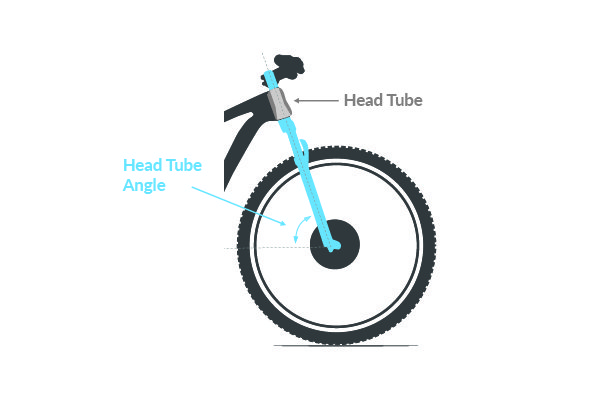
The head tube angle is the degree in which the frame holds the steer tube. The steepness or slackness of the head tube angle will affect the bikes performance on the trail. For instance, a steeper 71-degree head tube angle benefits the frame's climbing efficiency and slow-speed maneuverability but makes it less stable while descending. A slacker 65-degree head tube angle increases the frame's stability while descending but the bikes climbing efficiency and low-speed steering is compromised. Head angle is one of several factors that can affect climbing, descending, and steering. Frame designers balance these factors to design ideal bikes for certain kinds of riding and terrain.
Most mountain bikes are designed with suspension. Suspension travel is the maximum distance the suspension can compress in its stroke. Travel is shown in millimeters or inches. For mountain bikes a small amount of suspension travel is 80mm and a large amount of travel is 200mm.
Mountain bikes generally have suspension in two places, at the fork, and in the frame. Bikes with supension only at the fork are Hardtail bikes and bikes with suspension in the frame and fork are Full Suspension bikes. The amount of suspension travel tends to relate to the riding category that bike falls into.
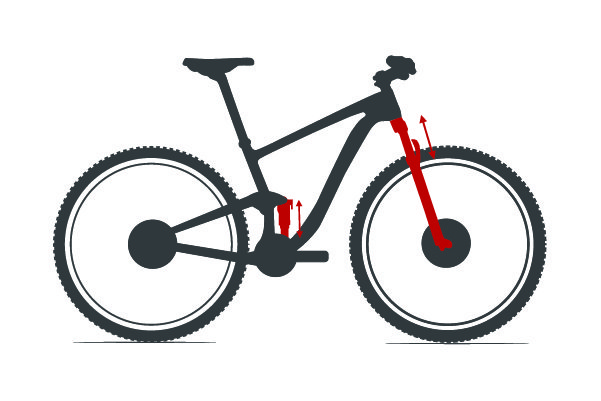

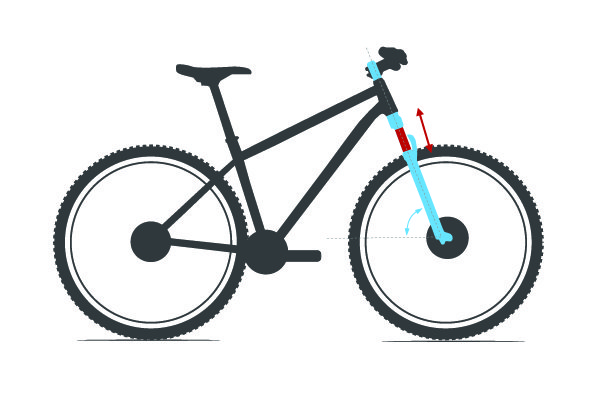
A Cross Country mountain bike is designed to be efficient on fast and flowy single-track loops intertwined with climbs and descents. The rider is focused on getting good exercise and maintaining a quick pace throughout the ride. A Cross Country rider finds equal amounts of joy in climbing as well as descending. You will also see these bikes referred to as XC for short.
Cross Country bikes are designed with that rider, and trail in mind. The frames are constructed with steeper head tube angles (67-72 degrees) and longer reaches that benefit the rider's body position while climbing. XC frames can be hardtails or dual suspension designs. The suspension travel for a Cross Country bike ranges from 80 to 120 millimeters. These bikes will be the lightest of the four categories, with an average weight between 19- 25lbs. The lighter the bike equals less energy exerted on climbs and longer distance rides.
A new sub-category of "down-country" bikes has emerged that pairs some of the more progressive geometry numbers of trail and all-mountain bikes with the shorter travel numbers of typical XC bikes. This combination makes for highly efficient machines that can be a bit more fun and confident when you pointing back down the hill.

A Trail bike is designed to handle varied terrain including berms, jumps, rocks and roots but still pedal efficiently up climbs. A trail bike rider is focused on sensations found while carving through turns and navigating through technical terrain including root splays and rock gardens. Trail bike riders generally have a relaxed paced ride with friends and hopefully beers awaiting you in a cooler at the end of the ride.
Trail bikes are designed to aid riders in changing terrain. They come equipped with slacker head tube angles (65.5-67.5 degrees) than a Cross Country frame and most come with a dropper post to improve the riders descending position. The majority of bikes in this category are dual suspensions with travel ranging from 120mm to 170mm. The average bike weight ranges from 27-32 lbs.
All Mountain and Enduro are a sub-category of Trail bikes. This burly end of the trail bike spectrum is designed for when the trail is steep and slack head tube angles (64.5-66.5 degrees) are needed for stability. They fall into the 150-170mm range of suspension travel. The extra suspension is helpful to navigate technical terrain.


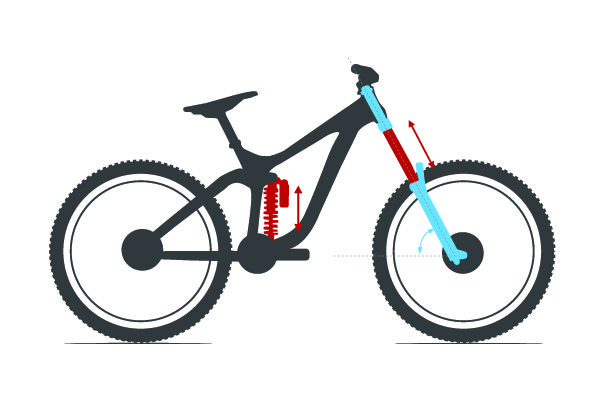
A Gravity or Downhill bike is designed to handle the steepest slopes, largest jumps and most technical trails. A Downhill bike is not designed for pedaling up hill. Most rides on a Downhill bike involve a shuttle truck, converted ski lift or simply pushing the bike to the top of the trail. The main goal for riders in this category is to refine descending skill and navigate technical trail with speed and grace.
Downhill bikes have the slackest head tube angles (63 – 66 degrees) to aid in safety and stability on steep trail. The suspension travel for a DH bike is 180 to 200mm. DH bikes are the heaviest of the four categories, built to withstand abuse. The weight ranges 35-41lbs.
Many Enduro bikes are beginning to blur the lines of gravity park bikes with longer travel, slack head angles, and capable components. Plus, these bikes can still climb fairly efficiently making for great backcountry freeride setups.
Gravel bikes live in a weird middle ground between true mountain bikes and road bikes. However, they very much deserve to be mentioned here. These bikes are designed to be equally at home on dirt as on tarmac. Equipped with wider (30-50mm) semi-knobby tires these bikes have earned a go anywhere at anytime reputation. The extra volume of the tires and lower tire pressure (compared to road bikes) allows Gravel Bikes to travel across dirt, gravel, mud and whatever else can be thrown in the way with relative ease while still being efficient on the road. The gravel bike rider likes to put a twist on normal road ride scenarios, wander off the beaten path and isn't afraid to enjoy adverse weather and trail conditions.
Most gravel bikes use a relaxed take on typical road bike geometry and have a moderately slack head tube angle comparable to most road bikes (68-70 Degrees). Many gravel and adventure bikes have incorporated cargo mounts to carry camp gear for overnight expeditions. Most of these bikes are rigid (no suspension) but there are a few options with very short travel designed to just take the edge off rowdier rides. With the extra volume in the tires and beefy frames the bikes average weight ranges 19-25lbs.
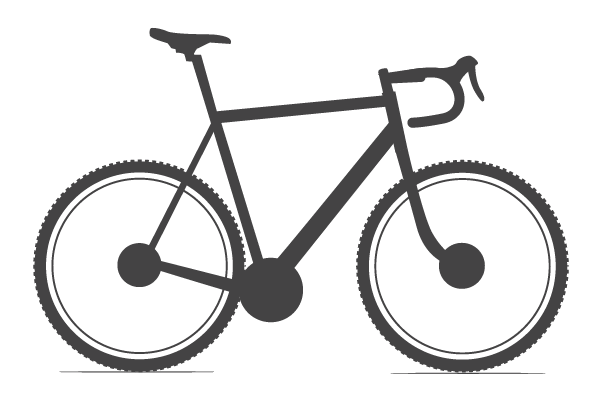
We can’t stress it enough; choosing a bike in the correct size for your body is the single most important thing to focus on when buying a new bike. Every rider has different proportions and flexibility, so choosing a bike that fits you properly will ensure that riding your bike is a fun experience, not a painful one. A good fit will help you be comfortable and efficient, and will help prevent repetitive-use injuries. The rider’s position on a mountain bike is less static than that of a road bike, so you have a bit more wiggle room on sizing.
Almost all bikes are designed to be adjustable within a given size range by moving a few parts or by swapping components for a different size. This adjustment range is limited, and it is best to start with a properly fitted frame. If a bike is much too large, the handlebars will be too far away and too high. The bike will also be difficult to stand over. If the bike is way too small, your handlebars may be too close to you and too low to reach comfortably. Either extreme also will adversely affect the weight balance and handling of the bike, so make sure you buy the right size. Size charts and calculators (like ours found here) are your best friend when choosing the best size. Once you have the correct size frame, you can adjust the saddle and handlebar position to dial in your fit.
Since every manufacturer “names” their sizes a little differently, the real measurements that matter are in the geometry chart below the bike’s description: don’t let the dozens of numbers confuse you: there 2 measurement that matters the most. Most experts suggest choosing a frame based off its reach and stack. Reach is measured from the center of the head tube to the center of the bottom bracket on a horizontal plane and stack is the vertical distance from the center of the bottom bracket to the top of the headtubes vertical plane.
To help you understand your bike sizing and fit, check out the handy guide and bike fit calculator we developed.
All bikes have parts attached to the frame that allow the bike to function, like handlebars, tires and wheels, referred to as “components.” The components that transfer your pedaling force to drive the rear wheel are collectively referred to as the “drivetrain”. The parts that support your body, like saddles, seat posts, stems and handlebars are usually called the “cockpit.”
Many components on bikes are interchangeable, so you can upgrade the bike as you see fit. For example, if you don’t like the handlebars or the saddle that came on the bike, They are easy to change and there are a multitude of options available.
The component quality is a primary factor in the cost of the bike. Component manufacturers offer their parts in a variety of levels that correspond with different price points. As with most things, as quality goes up, price also goes up. Higher-end parts use higher-quality materials and more precise manufacturing. This means they shift and brake more smoothly. They also weigh less, look better and last longer, as well. The highest-end components will also cost the most. Generally, the more expensive a bike is, the lighter and more functionally precise it becomes, so choose your desired components wisely.
Of course, one of the biggest factors to consider is your budget. A high quality, new mountain bike will usually cost in the range of $2500-$6500, although awesome deals do occasionally pop up that fall below that threshold. Any bike in this price range will function very well and last a long time.
If you want to go towards the high-end, prices range from $6000 and beyond for premium models. Above the $6000 mark you’ll get into high-end component groups and exotic frame materials like carbon fiber and titanium. The frame material makes an impact on how the bike rides, so if you want a quick primer, check out our article on mountain bike frame material.
Riding a lightweight bike is a dream, but consider again how you will use the bike- if you just plan on using the bike for light trail rides, a $10k carbon racing or enduro bike might not be the most practical option, but of course, it’s all up to you.
Many riders buy a low-end bike with the intent of upgrading it later. While that approach intuitively makes sense, you’ll find that upgrading the bike aftermarket almost always costs considerably more than buying a complete bike with the parts you want. If possible, opt instead to spend a little bit more on the bike with the nicer parts already installed – you’ll save money in the long run. If you’re budget only allows for a few upgrades, we recommend focusing on key areas like wheels and contact points. Upgrading wheels can reduce rotational mass, and dialed contact points will keep you comfortable mile after mile.
Having an All Mountain/Enduro bike does not grant you the ability to ride hard terrain. Hours should be spent refining your skills on features you are comfortable riding before riding more advanced terrain. Always look at features you are unsure about and know it is ok to come back and try next time. Stay Safe. Shred Smart!
Hopefully this short guide into mountain biking's categories has given you insight into a riding style that is right for you. To learn more about other considerations when purchasing a mountain bike, take a look at our articles about the basics of Mountain Bike Suspension, Frame Materials, Wheel Size and Mountain Bike Drivetrain.
Hopefully this short guide into mountain biking's categories has given you insight into a riding style that is right for you. To learn more about other considerations when purchasing a mountain bike, take a look at our other helpful articles on mountain bike basics.
SAVE 20% ON FIDLOCK
SHOP NOW
SHIP ALMOST ANYTHING & SAVE
SHOP NOW

,format=auto/globalassets/homepage/special-offers/2025_03/fidlock-sob.jpg)
,format=auto/globalassets/homepage/special-offers/2024-02/jensonusa-exclusives-sob.jpg)
,format=auto/globalassets/homepage/special-offers/2025_01/sob-jbs.png)
,format=auto/globalassets/homepage/special-offers/2024-06/one-up-hub-hub.jpg)
Follow Jensonusa